
Long-term Food Storage
DIY Food Storage means prepping yourself to save money. You could purchase long-term ready made long-term food storage. However, you can save quite a bit of money and enjoy the process if you do it yourself or along with your family.
When you stay ready, you don’t have to get ready for whatever. Start with easy affordable long-term food storage you can start immediately.
In the context of inherent, inescapable unpredictability, food storage helps to reduce the fluctuation of the food supply. It enables food to be enjoyed over some time (often months to years) as opposed to just immediately after harvest.
Improper storage settings and choices taken beforehand in the supply chain contribute significantly to food losses by making products more susceptible to deterioration over time.
(This post may contain commission affiliate links. I only recommend products I’ve used or trust. It comes at no additional cost to you if you choose to make a purchase and helps me continue providing you with free content.)
The Many Benefits Of Long-Term Food Storing
There are many benefits to long-term food storage, some of which include ensuring consumer access to produced and manufactured plant and animal food products throughout the year, preventing food waste by saving unused or uneaten food, conserving grocery store items for future use in cooking and emergency preparedness, and ensuring food availability during times of food scarcity.
By preventing deterioration, proper food storage not only helps you get the most out of your food budget but also preserves the nutritional worth and quality of the goods you buy. Additionally, safe food storage can aid in preventing hazardous bacteria-caused foodborne illnesses.
6 Plus Reasons For DIY Long-Term Food Storage
1. It’s Economical:
Eventually, food costs always rise especially with inflation and current recession predictions! Furthermore, occasionally, quickly, and significantly! Therefore, storing food will save you money by preventing you from purchasing more expensive products. Purchasing food storage for your home is almost always a wise decision. You will ultimately pay less when costs are higher if you purchase more food today. Also, it costs a lot to dine out. Compared to dining out or getting fast food, consuming food from your local grocery store is far less expensive.
2. Food Shortages:
When there is a lack of food production, such as when crops fail because of a drought, pests, or excessive rainfall, there may be a food shortage. However, human institutions like the government and public policy, as well as the uneven distribution of a nation’s endowment of natural resources, can also contribute to the issue.
Another significant factor in food shortages is war. A significant amount of the world’s wheat, corn, and barley are, for example, stranded in Russia and Ukraine due to the conflict, and an even greater portion of the world’s fertilizers are stranded in Russia and Belarus. As a result, the cost of food and fertilizer is increasing globally. Prices for wheat, barley, and various fertilizers have all soared since the invasion by 21%, 33%, and 40%, respectively. When there are food shortages, having food in your homes and storage facilities will prevent them and allow you to have plenty of food at home when there is a shortage.
3. Recession:

Inflation due to recession is a negative trend in the business cycle marked by a drop in output and employment, which has a knock-on effect on household incomes and consumption. Recessions cause a general drop in economic activity and a reduction in the amount of money flowing in, which “puts you at risk of defaulting”. It may be challenging to maintain your regular routine and other bills. However, if you’ve stored food in advance, you won’t have to worry about running out of food at those times.
4. Natural Disasters:
It’s crucial to realize that, wherever you live, you will eventually experience some sort of natural calamity. Contrary to popular belief, food storage isn’t just for those who believe that the world will end due to some calamitous occurrence; it’s also for those who realize that nature can be harsh and that there may be occasions when it gets in the way. These are all examples of natural disasters: Floods, tornados, hurricanes, thunderstorms, lightning, winter storms, temperatures that are extremely cold or hot, earthquakes, and volcanoes. If your home has food storage, you won’t have to worry about spending a few days trapped inside during typical disasters. You have plenty of food stored in advance, so you may easily unwind in your home until everything is put back in its proper place.
During the Texas Freeze in 2021, everything was shut down for over a week. We had no power, heat, phone service, nor internet throughout Houston. Because of an untimely “natural disaster” food actually had more value than money at this time.
5. Pandemics:
Using Covid-19 as an example, during those times the country was in lockdown, and businesses and companies were closed. There were only a few food supplies available, and food transportation wasn’t really an option. Some of us couldn’t go out to obtain food items because a “lockdown”. Food costs also increased dramatically as a result of the huge gap between supply and demand. Having food on hand during these times will protect your life, finances, health, and well-being.
6. Various factors: Various factors include a number of different combinations of other justifications for food storage. For example, if you were severely ill and had to stay at home for some time, you would only be able to survive if you had stored up your long-term food storage. A decrease in income or loss of employment are also important reasons to think about food storage. You and your family would be able to manage providing meals with just a little prepping.
Preparing to Store Your Food
As you get ready to take the audacious step of “long-term food storage”. You must keep in mind that there are specific preparations you must make before beginning. You could handle and preserve food more efficiently with the use of these preparations. Before storing food, there are numerous things to take into account. However, the actions listed below are a few that you should take into account:
1. Costs: Make a list of the food products you want to keep on hand. It may be necessary to use a scale of preference to avoid giving the less significant one precedence. Get ready to purchase more of the essential food products. Go to places such as local farms to pick your own food, Amish markets, farmer markets, Aldi, Save-A Lot, Costco, and Sams Club if you can. Make sure the prices are within your budget by estimating them. Once you’re finished, you can begin.
2. Space/ Location: You must make sure that your supplies are kept in the best areas if you truly want your food storage to last. In the end, your food storage won’t be much use to you because it was contaminated from being kept in a bad place. Finding spaces around your home that are cool, dry, dark or shielded from direct sunlight should be your first and foremost priority while storing food. Your kitchen, pantry, and basement, among many other places, might be the location or any dark unused closets.
How Long Can Food Be Stored
The shelf-life of food items varies depending on their classification, which includes perishable, semi-perishable, and non-perishable foods, so it’s vital to be aware of this when discussing how long food can be stored.
Dehydrated Foods: All prepared foods are regarded as perishable foods. Perishable foods must be kept at refrigerator or freezer temperatures in order to be stored for any period of time. Many perishable items should be consumed within 3 three to seven days if refrigerated. However, could be preserved fruits, meats and veggies using a Food Dehydrator. Once dehydrated, you could store fruits and veggies in mylar bags for up to 25 years if done properly. Meat jerky will last up to 1-2 years depending on how it was prepared. You can freeze homeade meat jerky for one year as an option, however, when thinking about food storage plan more on the side of not relying on a refrigerator or freezer. See large food hydrators here.
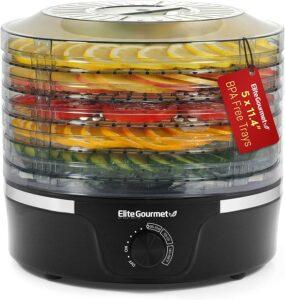
Depending on how they are handled and stored, semi-perishable food can either spoil rapidly or have a long shelf life. Semi-perishable items include dry mixes, flour, grains, and dried fruits. Semi-perishable goods can last up to a year without going bad if handled and kept properly, such as in a fresh, vacuum-sealed bag. Some can survive even longer when frozen.
Foods that don’t spoil quickly like canned items, spices, and dried beans are non-perishable. Unless they are treated poorly, they won’t go bad. However, even in perfect storage conditions, they may begin to deteriorate after a while.
Some of the best inexpensive methods for storing food correctly and extending its shelf life include canning, freezing, drying, and fermenting. Your food items might last longer before going bad if you used these storing procedures.
Different Types of Food Storage Supplies

Mason Jars: Mason jars prices seems to change like the stock market. I recommend buying new, but check places like Marketplace or OfferUp also. Certain foods can be preserved for up to 24 months using mason jars. Both high-acid foods (such as salsas, pickles, and fruits) and low-acid foods can be preserved in a variety of methods (meats and such). Jams, Jellies, Preserves or higher sugar products tend to last in the range of 18-24 months.

Mylar Bags: If you love easy simplicity, you’ll do best with good quality Mylar Bags. It’s my go to for storing food and I’ve found this to be the most affordable long-term food storage you can start immediately. You can literally start this coming weekend and accomplish your first bins in just a few hours. You’ll need:
- Bags of bulk beans, rice, ground coffee, flour, oatmeal, grits or pasta
- Mylar Bags (heat sealed lasts the longest)
- Oxygen Absorbers (get extra)
- Dried Bay Leaves or Food Grade Diatomaceous Earth
- Flat Iron or Iron (to seal the bag with heat, see this video)
- Black Permanent Marker
- Hard Opaque Storage Bin to Store All Your Sealed Bags (place this in a dark cool space)
Watch My Steps Using Mylar Bags For Long-Term Food Storage 😀
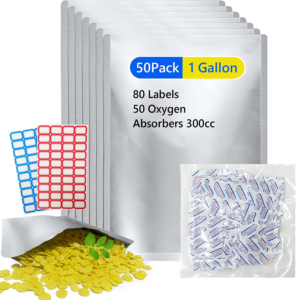
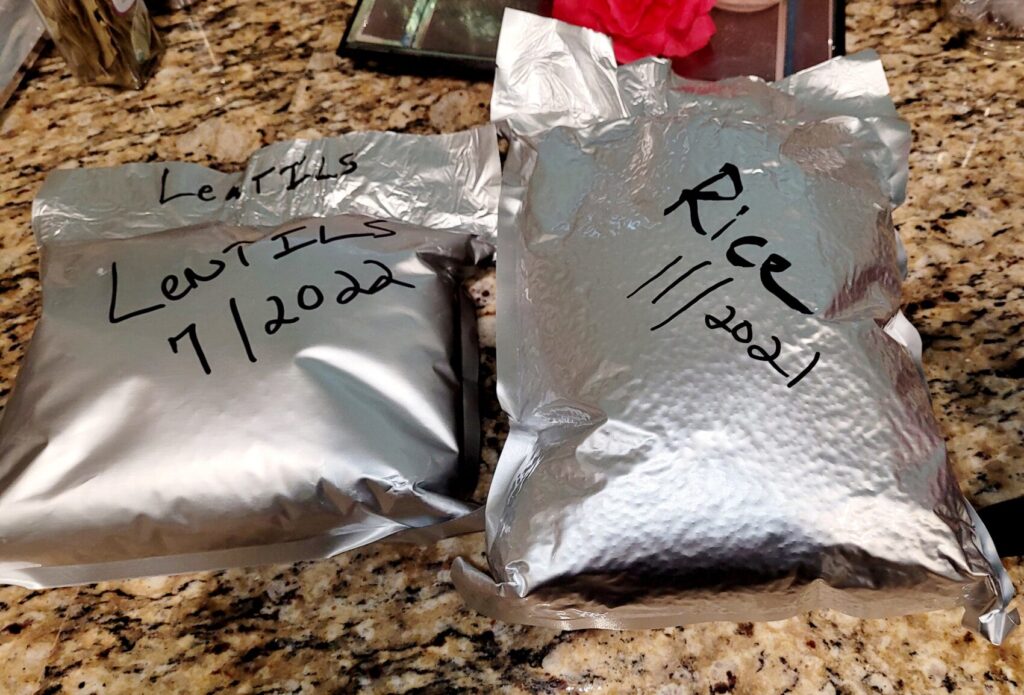
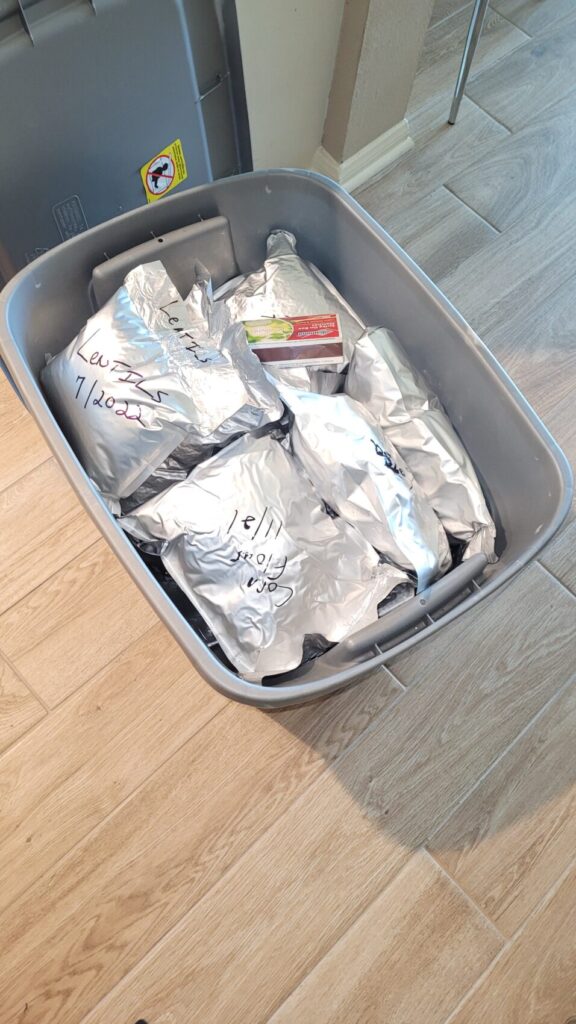
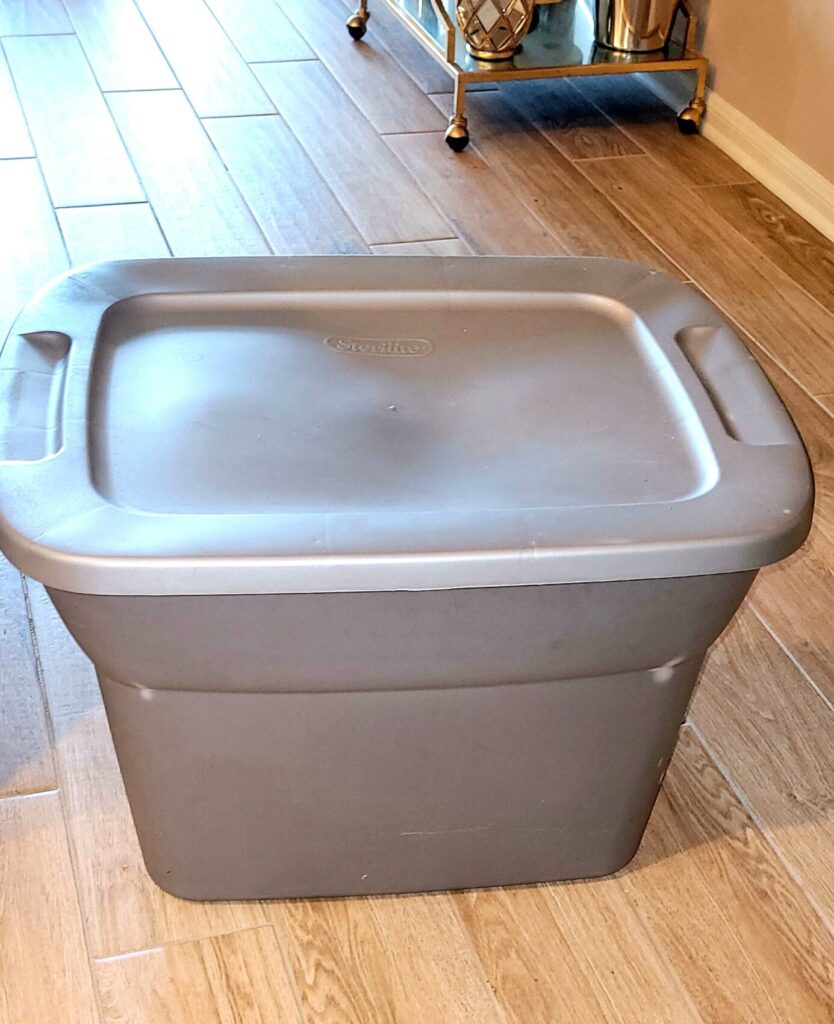


Food in mylar bags lasts for a long time, however depending on the food type, if the bag is sealed properly, and the storage environment. Foods with a moisture of more than 10% should not be stored due to the increased risk of botulism. Foods such as sugar could turn hard as a brick and have a funny taste over time if stored with oxygen absorbers. Read how long will sugar and other foods last in mylar bag. When properly stored in mylar pouches that are sealed, dried goods like beans, oatmeal, granola, cornmeal, flour and grains can last twenty to thirty years. Here are 25 Foods You Can Store In Mylar Bags.
Don’t open the oxygen absorbers until you’re ready to use them. They work pretty quickly. Immediately store those not being used in a tightly sealed mason jar. 300-500 cc oxygen absorbers will work in a one-gallon Mylar bag. You can also use the same oxygen absorbers for smaller bags.
Protect Long Term Food Storage
Believe it or not and according to the USDA, all foods have bugs, bug eggs and even maggots. The lack of oxygen in the bag will ward of the hatching of insects. The dried bay leaves are known to ward off insects as well. Diatomaceous Earth powder comes in a food grade and it has no taste. You can put 1 teaspoon of diatomaceous earth powder on your dried beans, rice, and coffee grains to ward of bug hatchings. Use 1 cup of diatomaceous earth for every 50 lb container of food.
Water Bath Canning:
Water bath canning is used for preserving foods with high acid levels such as most tomatoes, pickles, relishes, jams, jellies, and marmalades. For low acidic foods, such as meat and some veggies, you’ll want to do pressure canning instead, which is detailed in the next section.
Water bath canning is also considered an affordable long-term food storage you can start immediately. You can probably start quickly possibly using items you already have in your kitchen. Canned food in cute mason jars also make great gifts.
To get started you’ll need:
- Fresh fruits and veggies (or meats, soups, jelly concoctions)
- Lots of canning jars or lids (mason jars)
- Water Bath Canner (big pot with lid)
- Canning kit (includes funnel, jar lifter, tongs, jars and more)
- Canning recipe book (or check Pinterest…you may need pectin or a strainer depending on the recipe)
- Oven mittens
You may need other things depending on the recipe. Check out this video on getting started using items already in your kitchen.
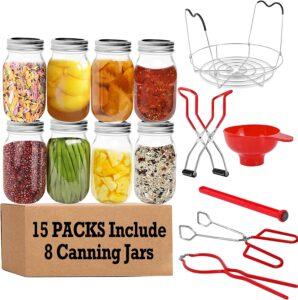

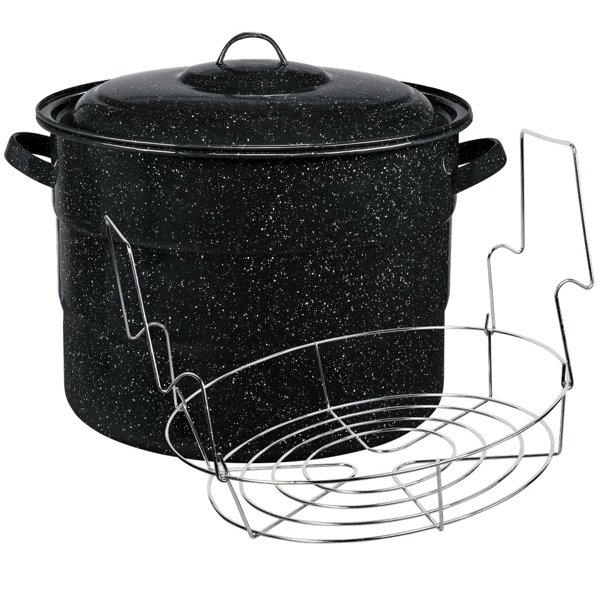
Step By Step Visual: Canning For Beginners
Pressure Canner: With pressure canning is more of a process. Foods are placed in cans or other similar containers and heated to a temperature that kills the bacteria that cause food to spoil. This process is known as canning. A pressure canner is a sizable pot with a cover that locks onto the pot and a dial or weighted gauge that lets you control the amount of steam pressure that develops inside the pot by adjusting the heat of the burner. To safely preserve vegetables, meats, poultry, and shellfish, pressure canners are necessary.
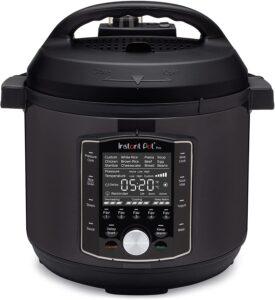
Pressure cooker and canners are currently running about $80-$330. While I wouldn’t call it affordable for everyone, it may however be a worthy investment for some. It’s somewhat of a longer learning process. I was honestly intimidated trying to learn how to pressure can beef stew, but some people may like this kind of challenge or science like projects which is why I’m still listing it as an option. For example, if you live in a high altitude area, there are separate guidelines when it comes to pressure cooking. After much research, I’ve decided I would rather take a hands on class on this process.
Here is a video on pressure canning beef stew. She makes it look easy actually.
Steaming Basket: This steamer basket makes it simple to blanch a variety of foods that need to be done so before being canned, frozen, or freeze-dried. Being that it fits in both your pressure canner and instant pot, it is a functional accessory. You can also steam your own food using a skillet and a little water. There’s lots of food steaming hack videos on Youtube.
When In Doubt About Long-Term Food Storage
The National Center for Home Food Preservation is your source for current research-based recommendations for most methods of home food preservation. The Center was established with funding from the Cooperative State Research, Education and Extension Service, U.S. Department of Agriculture (CSREES-USDA) to address food safety concerns for those who practice and teach home food preservation and processing methods.

Conclusion: In addition to storage, food preservation is crucial. Some may not take proper precautions after storing their food, which leads to contamination and food spoiling. As money loses value, food stockpiling protects you from having to pay rising food prices. Additionally, it is economical and convenient.
I hope you’ve found my Affordable Long-Term Food Storage You Can Start Immediately article informative and will be inspired to take action soon. Subscribe to be notified when I post semi-monthly blogs or follow me in Pinterest! Thanks for reading 🙂
#lanidoesit #foodpreservation #longtermfoodstorage
![]()
